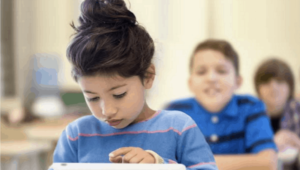Why PD for ELL Educators Matters

“When asked what they want for their children, parents, and community members overwhelmingly agree that they want the best teacher possible in every classroom. Research confirms that the most important factor contributing to a student’s success in school is the quality of teaching…Professional development is the most effective strategy schools and school districts have to meet this expectation.”
~ Stephanie Hirsch, Executive Director, Learning Forward in Why Professional Development Matters
There is widespread and universal agreement among teachers and the education field at large that professional learning is an essential component of ensuring student success for all student populations.
Even amid rapid changes in instructional models and growing diversity of student populations, many teachers are still stuck participating in professional development opportunities that are better matched to the needs of yesteryear.
Potential of Personalized PD
There is growing awareness of the potential of personalized learning models for teachers. See for example, Moving PD from Seat-time to Demonstrated Competency Using Micro-credentials and Getting Smart on Transformative Professional Development.
In Preparing Teachers for Deeper Learning: Competency-Based Teacher Preparation and Development, we argued that in order for the teaching field to create and sustain personalized learning environments, professional learning for teachers has to evolve as well. (A 2015 follow-up to this project reached similar conclusions for leadership preparation and ongoing professional development.)
As we described in Preparing Teachers, educators deserve the same blended, competency-based, deeper learning opportunities that their students do, including:
- Some element of teacher control over time, place, path and/or pace;
- Balance between teacher-defined goals, goals as defined by administration through teacher evaluation efforts, and school and district educational goals;
- Job-embedded and meaningful integration into classroom practice; and
- Competency-based progression.
This next generation of professional learning will enable better alignment to specific teacher needs. While all teachers would benefit from this type of personalization, professional learning is absolutely essential for teachers who serve unique student populations. One example is English Language Learner (ELL) educators.
PD for ELL Educators
ELL students face the unique learning challenge of developing skills and content mastery while simultaneously acquiring a new language–often when their native language is not yet fully mastered. This means that teachers must also simultaneously meet these instructional goals. A team of Stanford researchers further describes this challenge:
“While supporting access to content, teachers of ELLs are called upon to accelerate English language development and literacy and, in bilingual classrooms, native language and literacy development. Thus teachers need to know how to create classrooms that are supportive of using and learning language. Such classrooms benefit all students and are essential for ELLs.”
They go on to recommend teachers must learn to:
- Build opportunities for students to learn language and content from each other through purposeful, carefully structured and scaffolded tasks;
- Create engagement and discussion opportunities that socialize students to the language of the discipline through structures and routines that develop skill in disciplinary discourse;
- Carefully organize groupings (pair, small group and whole group) in classrooms to amplify and enrich the opportunities for comprehension, discussion and interactions with ideas;
- Consider student’s language proficiency and native (home) language when organizing students in groups for the purposes of learning (mixing diverse proficiency levels of the same native language) and production (mixing students from diverse native languages); and
- Take advantage of the assets of diverse students by understanding students’ language skills and their culture, background knowledge and experiences.
In the ASCD Guide Getting Started with English Language Learners, author and nearly 30 year veteran teacher Judie Haynes acknowledges similar needs when describing key concepts that are essential for teacher and administrators to understand about English Language Learners and addressing common myths about them. The book’s appendix offers 11 professional development activities designed for teachers and administrators to meet what she identifies as key goals for ELL PD:
- Understand key concepts of second-language acquisition;
- Develop cultural sensitivity and appreciation of diverse cultures; and
- Acquire strategies designed to help instruct ELLs in their general education classroom.
Haynes explains,”A good staff development [ELL] program provides educators with strategies to meet the social, educational and affective needs of ELLs. Good programs also give teachers information about second-language acquisition, diverse cultures and differentiating instruction for ELLs.”
Join the #SupportELL Conversation
Are you an ELL Educator? We are conducting an analysis of promising new tools and instructional strategies supporting English language learners and teachers. The culminating publication will feature strategies, tools, policies and supports for students and teachers in the field. We’d love to learn more about professional learning and ELL educators in your school or district.
See “Next-Gen Personalized Learning for ELL Students” for our guiding questions and ways to add your voice to the national conversation about English Language Learning, and:
- Shoot us an email with your responses or your interest in writing a guest blog by Friday, 3/25 to [email protected] with “ELL” in the subject line.
- Share your favorite ELL tool, tip or strategy, by tweeting us @Getting_Smart using the hashtag #SupportELL.
This blog is part of the Supporting English Language Learners Series with support from The Bill & Melinda Gates Foundation. For more, stay tuned for the culminating podcast, infographic and publication.
For more on this topic see:
- Next-Gen Personalized Learning for ELL Students
- Supporting all Teachers to be Teachers of ELLs
- Supporting ELL Students with Automated Writing Feedback
Stay in-the-know with all things EdTech and innovations in learning by signing up to receive the weekly Smart Update. This post includes mentions of a Getting Smart partner. For a full list of partners, affiliate organizations and all other disclosures please see our Partner page.




Judie Haynes
Thanks Carri. I just came across this blog because it was posted on #ELLCHAT. Thank you for including Getting Started With English Language Learners in your article.
Carri Schneider
Thank so much Judie for the great publications, your kind words and for all your ongoing work with #ELLchat.
ilya zeldin
Great to see front-row attention given to PD for teachers. The big challenge we hear is how learning can move from the realm of one-size-fits-all and become more personalized based on understanding what skills are important, what teachers know and don't know about these skills, and who needs training to address skills gaps. Thank you for this coverage.